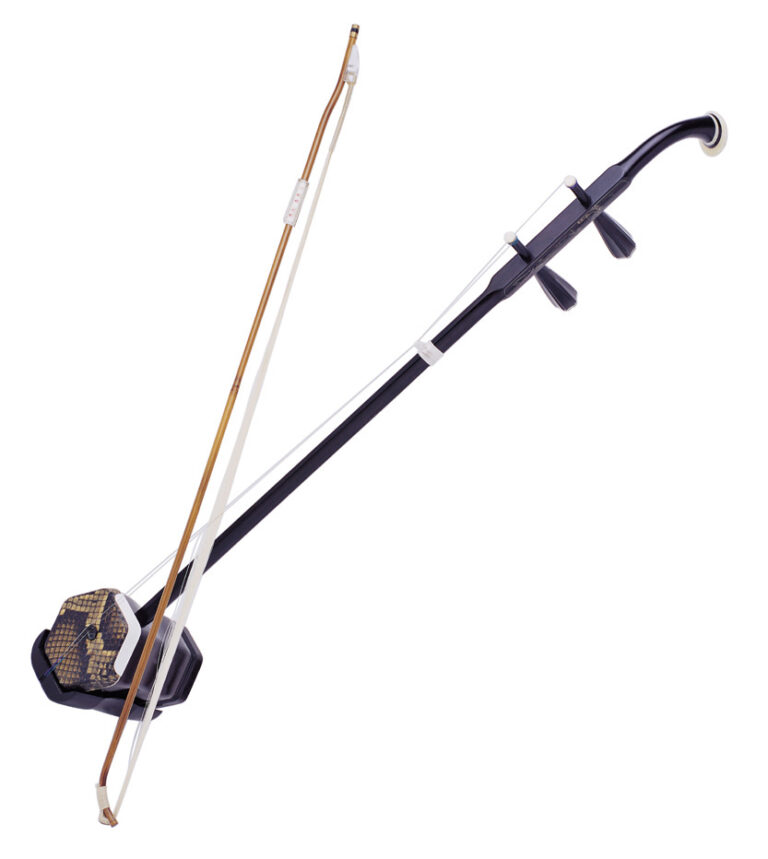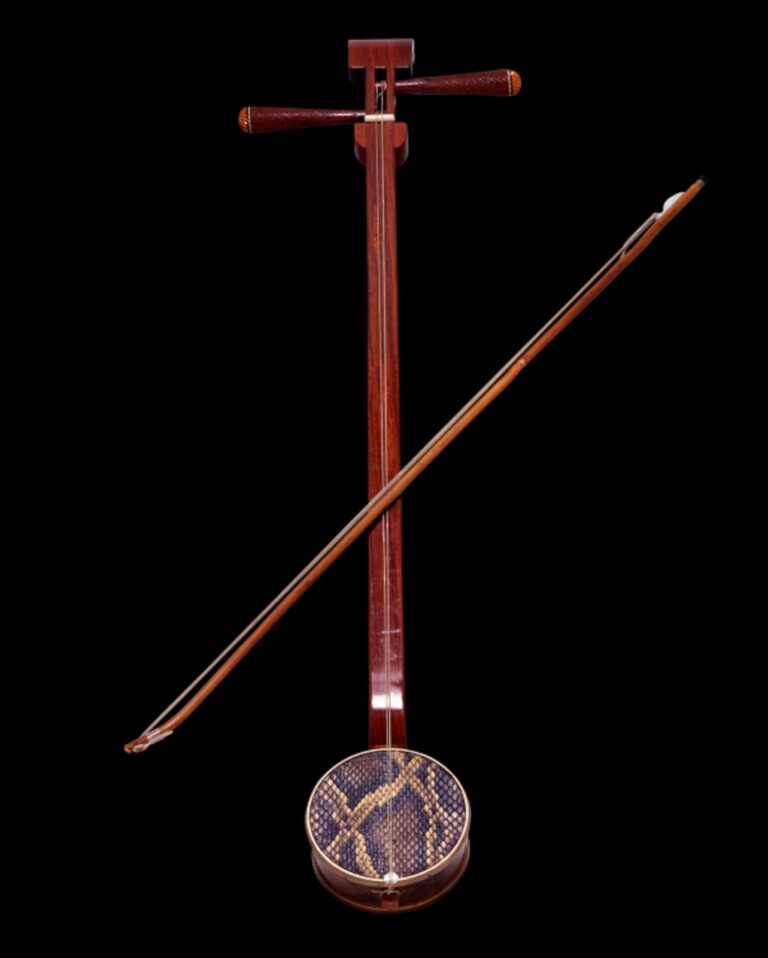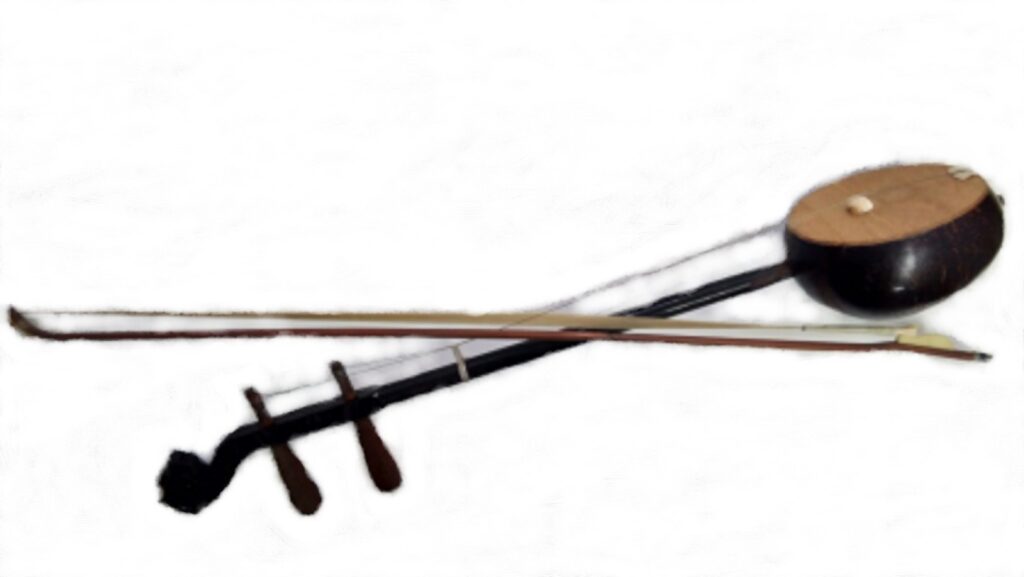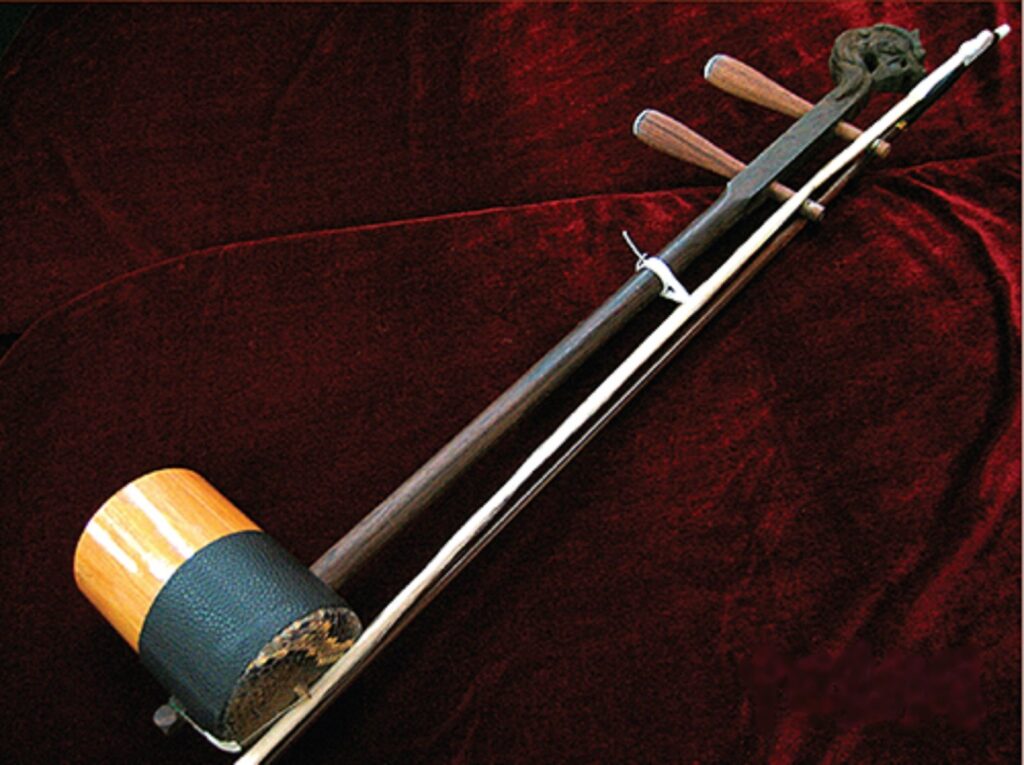中國民族音樂資料館 Chinese Music Archive
弓弦类 Bow String Instruments
二胡 - Erhu
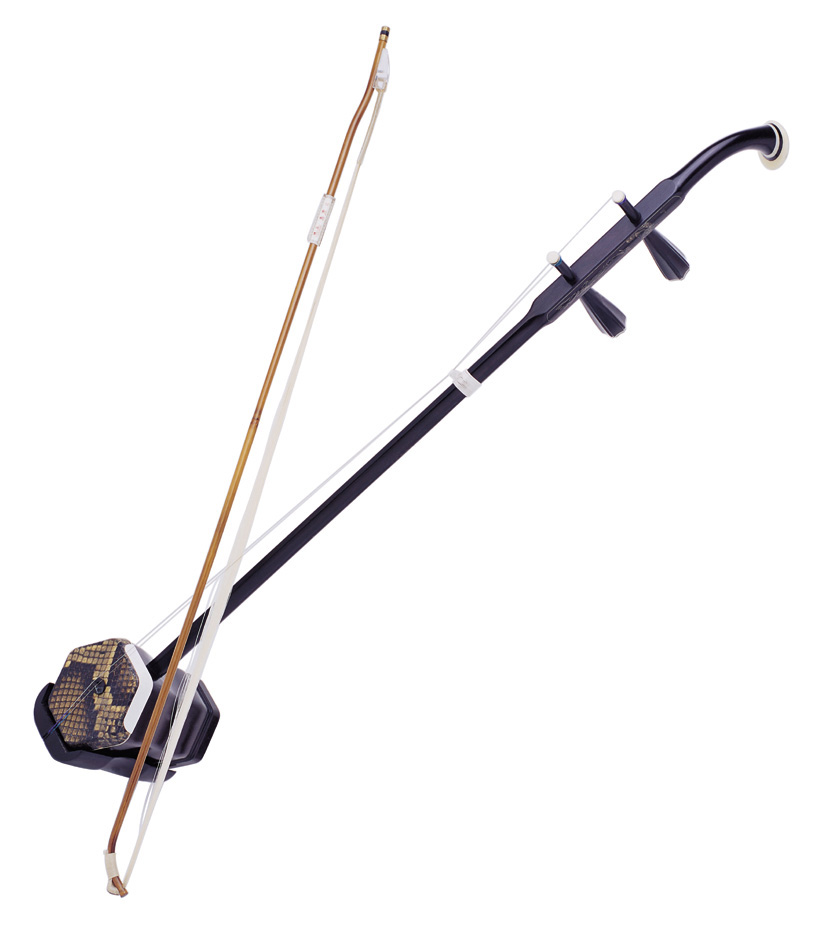
二胡是我国历史悠久、流行普遍的拉絃乐器。它的前身最早可见于唐朝,当时以竹片为弓,称为稽琴,后亦称奚琴;到北宋时代,以马尾为弓者由北方少数民族传入中原,称为胡琴;到了元朝开始在全国广泛流行。经历代演奏者的长期实践,随著演奏技术的发展提高,其结构形制不断改进;又根据流行地区和不同应用的需要,逐步演化出了若干不同的品种(如京胡、板胡、二胡、四胡、坠胡等),二胡(亦称南胡)是其中的一种。后来,二胡又分化出了高胡(高音二胡,亦称粤胡)、中胡(中音二胡)、大胡(大二胡)等,其大小不一,奏法基本相同。
二胡在相当的时期内,大多用于戏曲伴奏和某些地区性的民间音乐合奏(如“江南丝竹”等);直到五四运动之后,由刘天华先生开始,二胡才有了独奏表演,亦成为院校的教学内容,走上了专业化的道路。抗战时期,它被用于新歌剧和救亡歌曲的伴奏,在革命文艺活动中发挥了很大作用,新中国成立后,由于国家的关怀重视,二胡的发展提高很快,形制已基本统一,演奏方法更加科学化、系统化,演奏技巧和表现力已相当丰富,应用也更加广泛。
二胡的基本音色圆润优美,音域可达三个八度以上,能做各种不同幅度的力度变化和非常细緻的音色变化,因此,在其音域许可的范围内,能演奏各种不同节奏、不同速度、不同风格的曲调,表达出各种不同的思想感情,特别对于演奏歌唱性较强的抒情旋律尤为擅长。它在独奏表演中,不但适于和扬琴及小型弹拨乐队等伴奏形式合作,而且适于和钢琴伴奏合作;它在伴奏和合奏中是主要的旋律乐器,能与同类拉弦乐器、弹拨乐器及吹管乐器奏出很好的和声或複调效果;此外,它在与琵琶、扬琴、古筝等弹拨乐器或与同类拉絃乐器的重奏中,也能使其乐器性能得到较好的发挥。
二胡的表现力也有一定的局限性,例如,高音区力度不能奏得很强,中低音区奏八度之外的连续快速跳进(指非保留空弦的)比较困难,以及总的音域尚不够宽,音量还不够大等,这需要由制造、教学和演奏等有关人员共同努力,继续改进,使这个深受群众欢迎的乐器逐步地更加完善起来。
Erhu is a popular bowed instrument and has a long history since Tang dynasty in China. In the early times, its bow was made by bamboo and had a name called Ji-qin. Later it was renamed xi-qin. In Northern Song dynasty, the northern minorities introduced their huqin to us, of which, the material of the bow was changed from bamboo to horse tail. By Yuan dynasty, it was widely spread in China. Under a long period of development, it derived gradually into various species (e.g. : jinghu, banhu, erhu, sihu, zhuihu, etc.), erhu (also known as nanhu) was one kind of it. Later on, the erhu was differentiated into gaohu (tenor erhu), zhonghu (alto erhu) and dahu (bass erhu) according to their pitch and sizes. While their performing techniques were basically the same.
In a long period of time, erhu was used as an accompany instrument for the opera or used in the regional folk music ensemble (e.g.: Jiangnan Sizhu). Around 1919, LIU Tian-hau began to use it as a solo instrument and wrote training materials for it in the course of the Universities’ training centres.
Erhu has a beautiful timbre and its range of scale reaches to three octaves in normal. Therefore, to the extent permit of its range, it can play all kinds of different rhythms, different speeds and different style of tunes. In solo performances, it is not only suitable for performing with yangqin or small plucked string accompaniment, but also suitable for the piano accompaniment. It is one of the main melodic instruments in the ensemble. It can play harmoniously with other string and wind instruments.
It is still some room for the improvement of the erhu. Especially, reflected in playing the strong action on the high ranged area, playing the rapid notes out of an octave. It also has the problems of too narrow range and not enough volume. To make the instrument more perfect gradually, these can be solved and improved in future through the experiences of teaching, performing and manufacturing.
京胡 - Jinghu
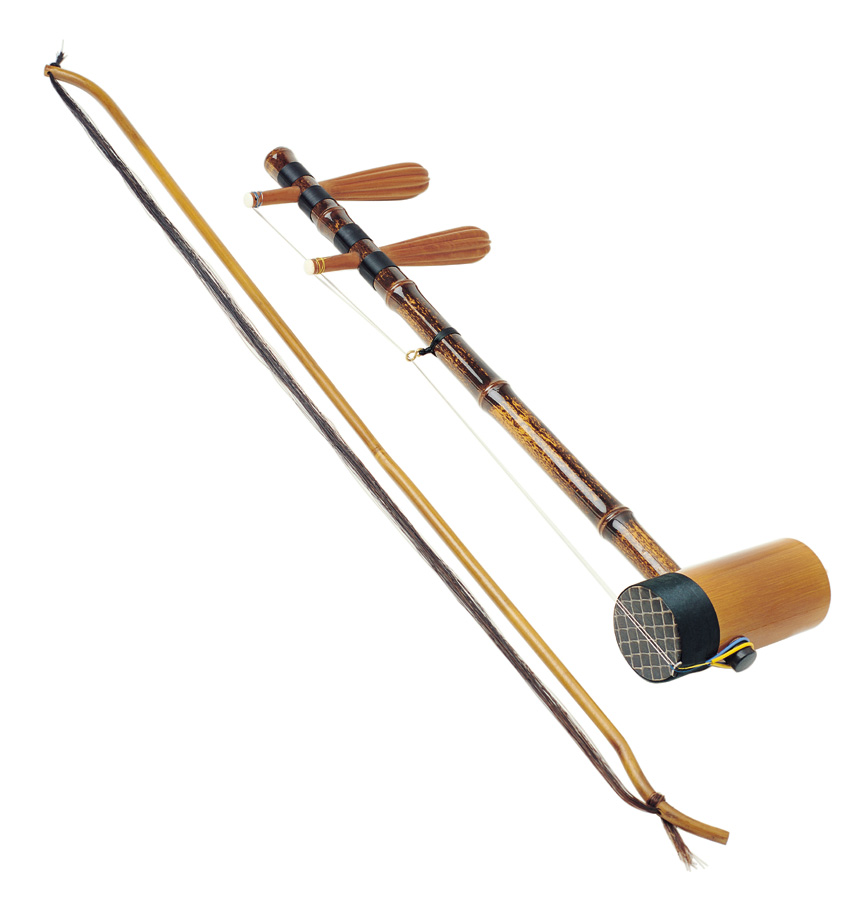
京胡,最初也称胡琴,是京戏的主要伴奏乐器。清乾隆末年(一七八五年左右)随著京戏的形成,在胡琴的基础上改制而成。
京胡的琴筒竹制,蒙以蛇皮,(现在有用尼龙织品代替蛇皮的)琴杆竹制。据京剧界老艺人说,早期的京胡用软弓拉弦(就是不张紧马尾的弓子),十九世纪后才出现硬弓。现在安徽、河南等省仍有人使用软弓演奏。使用这种弓演奏,有一种特殊的碎弓效果,演奏技巧也是很高的。
Jinghu is a kind of fiddle and is also called erhu, which is one of the main instruments for accompaniment of the Beijing Opera. It was derived from huqin at the time of the formation of Beijing Opera around 1785. The instrument is made of bamboo and at one end of the sound box is covered with snake skin and is steadily changed to use nylon fabric for replacement nowadays. According to some old artists, they said that in the early time the tension of the bow used is very loose and soft than that used today. The tight and hard bow is appeared at around 19th century. The old style bow is still be used in Anhui and Henan today. The performance with soft bow should have a higher skill and can get a special effect in the technique of broken arch.
高胡 - Gaohu
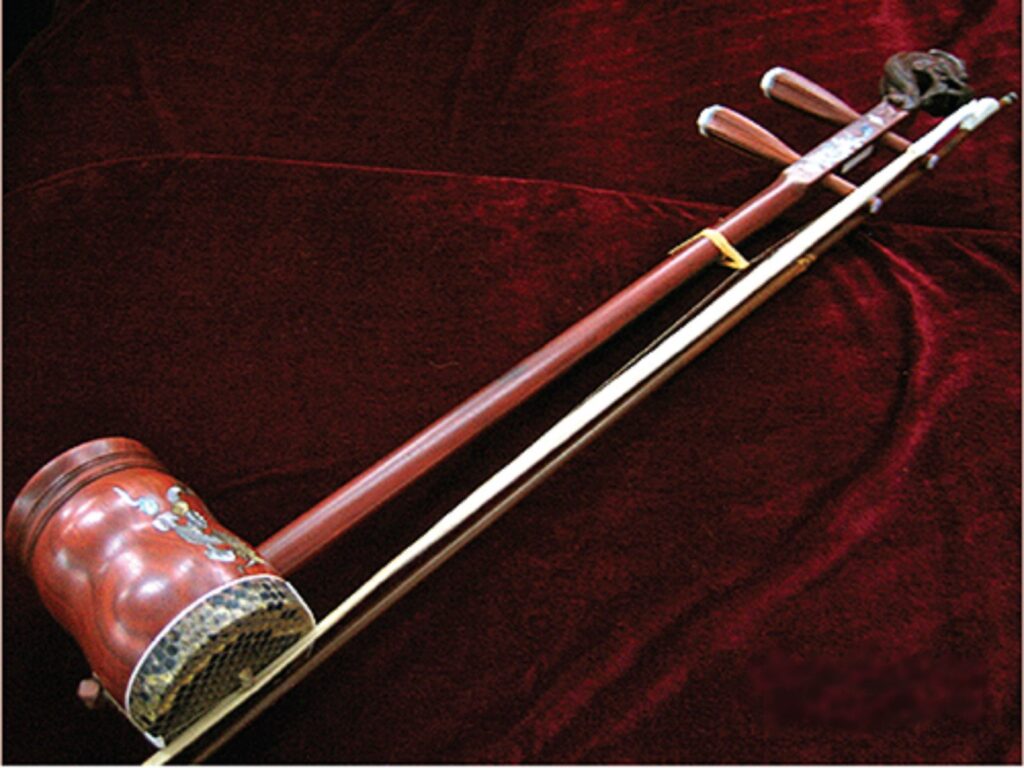
高胡,就是广东音乐中的粤胡,在广东也称为二胡。约在上世纪二十年代根据二胡改革而成,琴筒比二胡小,定音比二胡高四至五度,所以叫它高胡。外弦用钢丝弦,内弦用钢丝缠弦(也有用丝弦的),拉时两腿夹琴筒,用以控制音量及减少沙音,高胡音色清脆、嘹亮。
新中国成立后,得到广泛的应用,现已成为民族乐队中的高音拉絃乐器,它用于合奏、伴奏和独奏。
Gaohu is a kind of fiddle known as Yuehu in Cantonese music and is also called erhu by Guangdong musicians. It was reformed from the erhu in the 1920s. The sound box of gaohu is smaller than that of the erhu and it is tuned at g-d or a-e. This high pitch tuning let it has the name of gaohu. The strings it used is made of steel. One of it is bound with silver. When in performance, the instrument is set between the two knees. It is now widely used in the traditional orchestra as high pitch instrument for orchestral works, solo and accompaniment.
二弦 (广东) Erxian (Canton)
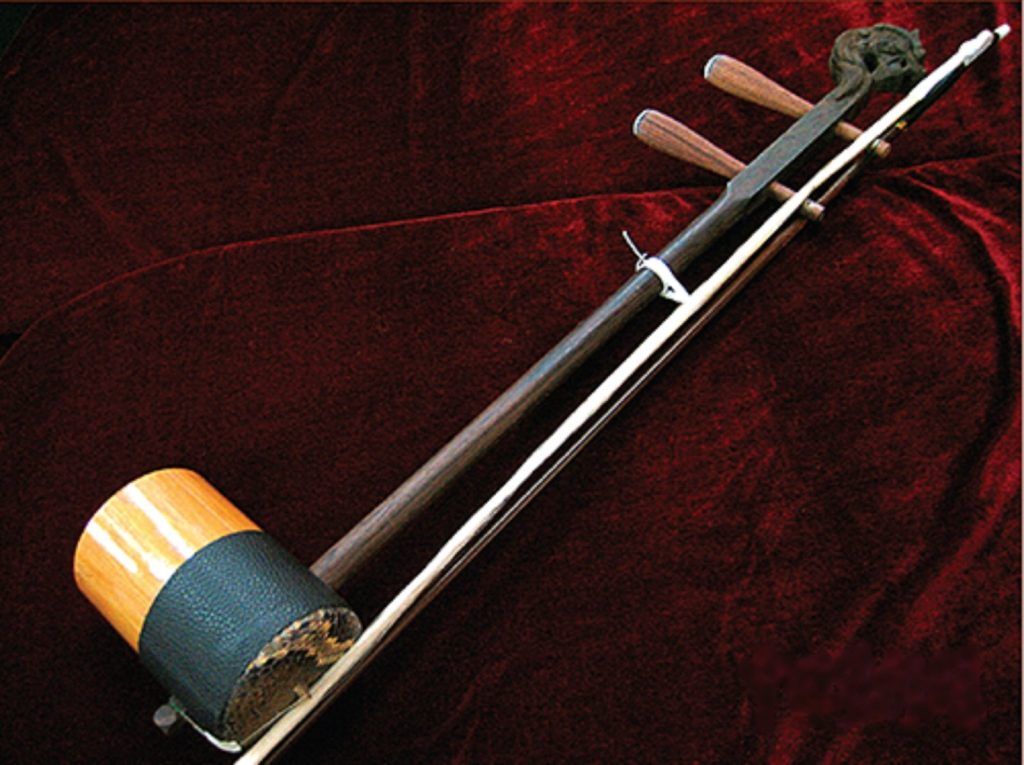
二弦,拉弦乐器。大约在清代咸丰年间(1855),从徽班引进二黄时,吸收徽胡而创制出之“广东二弦”,在粤调音乐中通称“二弦”,但与各地之二弦及潮州二弦不尽相同。
二弦,琴筒竹制,面径7公分,筒深13公分,前内端,镶扁平硬木略呈圆锥形粗环,使振膜稍窄,蒙以厚蟒皮,后端全空,发音粗犷,带沙音。琴杆木制,平头无饰,约长47公分,上设两后揷式琴轸,设千斤,张粗弦,配硬弓。
在早期粤调音乐的丝竹管弦组合五架头(二弦、提琴、三弦、月琴、箫笛)中,为领奏乐器,即“头架”(上手)。
Erxian, atwo-stringed bowed instrument, was derived from the major musical string instrument of Anhui Opera around 1855. This new instrument was then treated as CantoneseErxianwidely and with different aspects from the erxianof the other places in China.
Erxian is a fiddle with a bamboo sound box and is covered with snake skin.It has a long stem with two silk strings bound over a bridge, and which has now changed to steel ones. The tight and hard bow is used for the performing.
This instrument was widely used in the traditional Cantonese orchestra and was the main and leading instrument of wujiatou in Cantonese music.
中胡 - Zhonghu
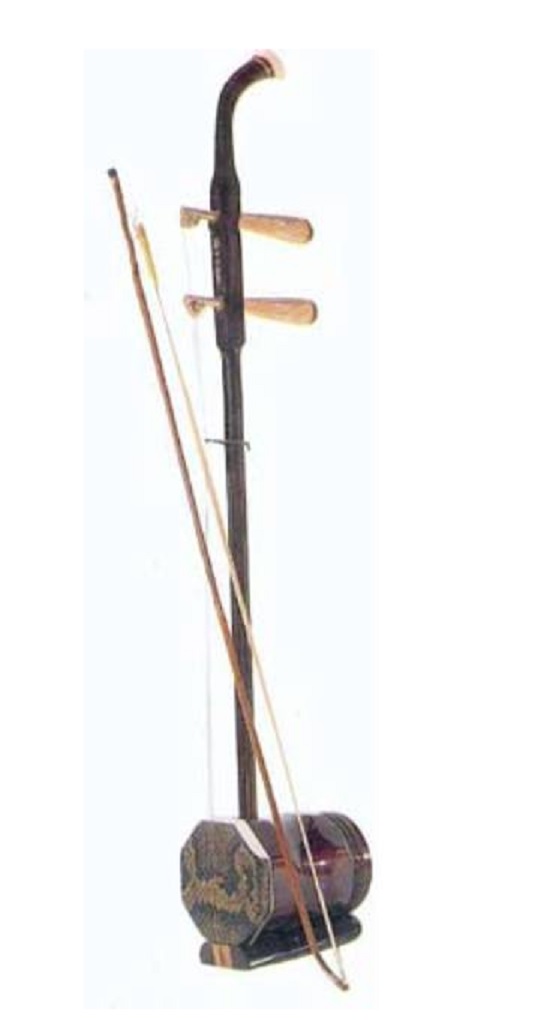
新中国成立后,我国一些民族乐队为了加强中音部的表现力,刘明源率先在二胡的基础上创制了中胡。现在已成为民族乐器中广泛使用的乐器,它不但用于合奏、伴奏,而且也用于独奏。
–Zhonghu
Zhonghu is a kind of fiddle modified from erhu by LIU Ming-yuan. Its reformation is to fulfill the need of alto instrument in the traditional orchestra. It is a solo instrument and be widely used in the ensemble and the accompaniment.
椰胡 - Yehu
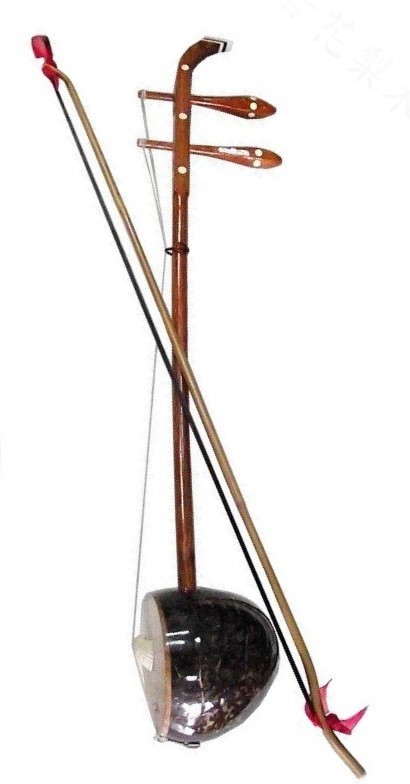
椰胡是广东戏曲、曲艺的伴奏乐器,形状与板胡相似,音箱用椰子壳制成,面板用薄桐木板,背面开五个小孔,成金钱眼状,用小贝壳做马(也有用竹马的),张二根丝弦,音色柔和浑厚,除作为伴奏乐器外,已成为独奏、重奏和合奏乐器。
Yehu is a kind of fiddle used in Cantonese Operatic music. It has a similar shape as banhu. The sound box of the instrument is made with coconut shell and covered by a thin Chinese parasol plates. At the back, it has five old coin-shaped holes. It has a set of two silk strings mounted over a shellfish as bridge. Apart from accompaniment, it is also a solo instrument and always be used in ensemble music.
坠子 (坠胡)
Zhuizi (Zhuihu)
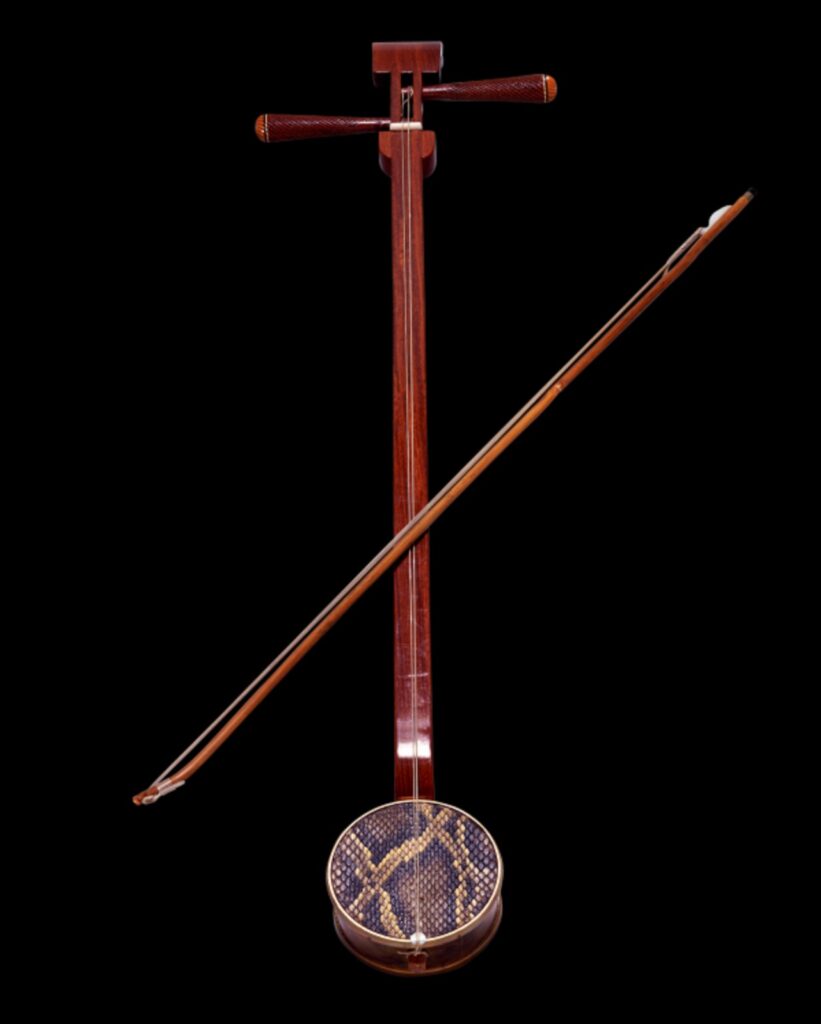
坠子也称坠琴,是河南曲艺坠子书的主要伴奏乐器。约在清末演唱莺歌柳书(一种说唱音乐)时,将伴奏乐器小三弦,改革成为坠琴,坠琴的音箱如三弦而稍小,鼓面由蟒皮改为桐木板,琴杆保留了三弦的指板,用马尾竹弓拉奏,因而成为拉弦乐器,音色浑厚。
另一種制度的稱為墜胡或二弦,琴筒如二胡而稍長,一端蒙蛇皮,琴杆如三弦的指板,音色高亢、柔美,是河南戲曲音樂小調曲子和山東琴書、呂劇等的主要伴奏樂器,現在主要流行於河南、山東一帶。
墜琴和墜胡除用於曲藝、戲曲的伴奏外,還用於合奏和獨奏。
Zhuizi also called zhuiqin is the main instrument for accompaniment of Henan ballad singing. It was reformed from the quyi accompaniment instrument sanxian. Its sound box is slightly smaller than the sanxian and covered with thin Chinese parasol plates instead of snake skin. It retained sanxian’s long finger board and used bow to perform and became a kind of bowed instrument. Another kind is called zhuihu or erxian. Its sound box likes erhu with a sanxian finger board is used for accompaniment of Henan, Shandong Operatic music. Zhuiqin and zhuihu are also used as solo instruments and always be used in ensemble works.
板胡 - Banhu
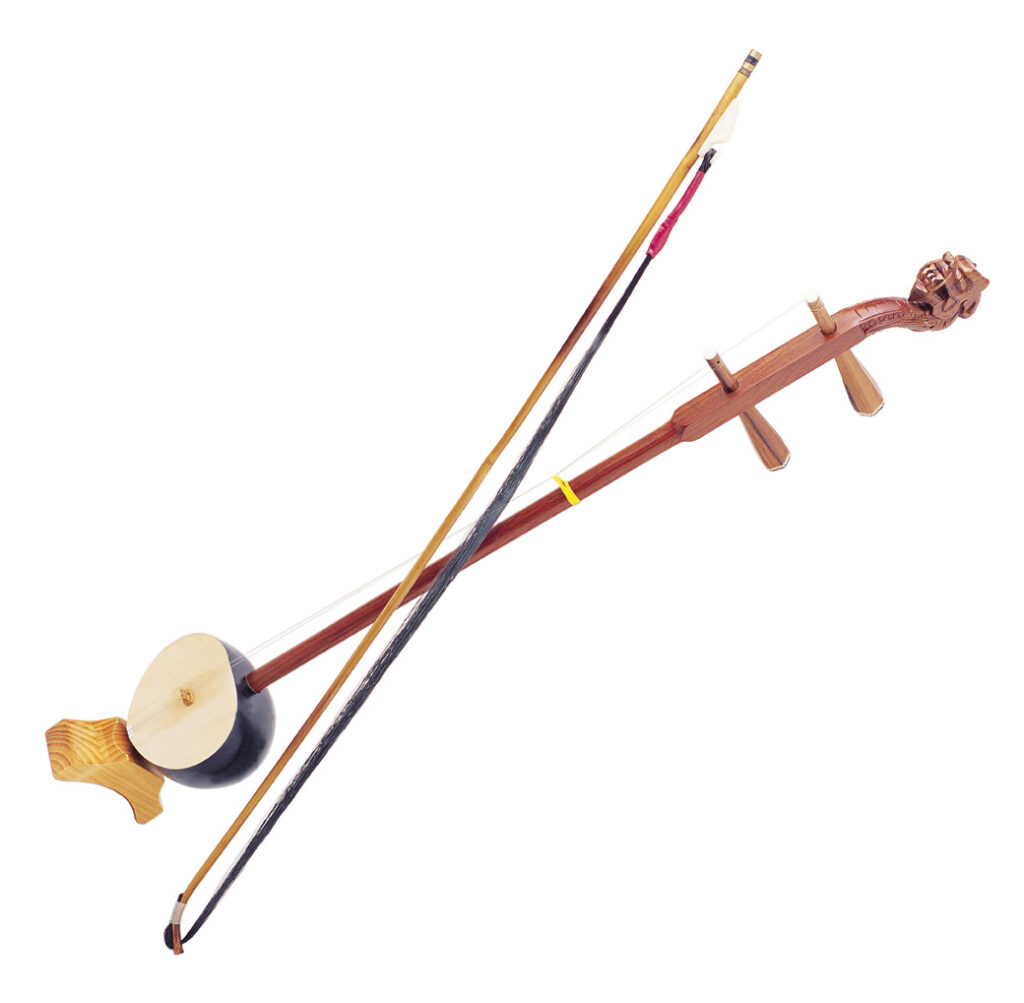
板胡,又名梆胡、秦胡、胡呼、大弦、瓢等,它是伴随戏曲梆子腔的出现,在胡琴的基础上产生的乐器。大约在明末清初,随著梆子腔的兴起而流行,后为多种地方戏曲和曲艺採用,如河北梆子、评剧、吕剧、豫剧、晋剧、秦腔、蒲剧、郿鄠、兰州鼓子、道情等。
板胡的音箱用椰壳或木制,面板用薄桐木板,琴杆用较硬的乌木或红木,张二根弦、马尾竹弓,音色明亮、高亢,适于表现热烈奔放的曲调。
Banhu is a kind of fiddle also known as banghu, qinhu, huhu, daxian and piao. It is an accompaniment instrument for bangzi operatic music. Around the early Qing dynasty, with the rise of bangzi opera, it was widely used by Hebei bangzi, Ping opera and also Shangdong, Henan, Shanxi, Shaanxi opera. The sound box of the instrument is made with coconut shell or wood and cover with thin Chinese parasol plate. The stem is made with hard wood and has a set of two strings performing with bow. It is suitable to play warm and flowing melody.
擂琴 - Leiqin

擂琴又称大雷,是王殿玉在坠琴的基础上改革制作的,琴筒铜制,前面蒙蟒皮,琴杆与弦轴用硬木制,两轴,张弦两根,五度定弦,用马尾弓拉奏,全长约一百一十釐米,音量较大,音色柔和圆润,可类比人声、多种管乐器和打击乐器演奏的音响效果、戏曲唱腔、鸟兽鸣叫声等。并有独特的按指方法和演奏技巧,俗称“大雷拉戏”、“单弦拉戏”、“巧变丝弦”等。
Leiqin also known as dalei is modified from the zhuiqin by WANG Dian-yu. It has a bronze sound box and is covered with snake skin in one side. The stem and the tuning peg are made of hard wood. It has a set of two strings tuning at a range of perfect fifth and playing with a bow. The whole instrument is approximately 110 cm. The sound is loud and the timbre is soft. By means of a unique methodology and performance skills, it is always performed to imitate human sounds, wind instruments and percussions, operatic singing, voice calls of animal, etc. It is commonly known as Dalei laxi ( Operatic songs by dalei), Danxian laxi ( Operatic songs by xianzi) and Qiaobian sixian (Capricious variation by string instruments).
四胡 - Sihu
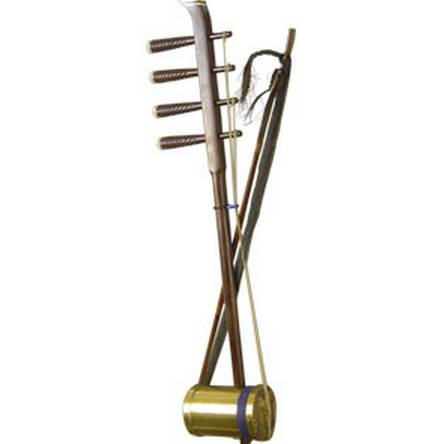
四胡,也称胡琴,蒙古族称为侯勒、四弦,《律吕正义后编》中还称它为提琴。十八世纪以前已经流行于我国内蒙和华北地区,为蒙、汉两族人民常用的乐器,主要用于说唱、二人台、皮影等的伴奏和民间器乐合奏,在内蒙古地区也用于独奏。
四胡的琴筒木制,蒙以蟒皮,琴杆用乌木或红木制成,张四根弦,第一、三弦(内弦)和第二、四弦(外弦)各为一组,每组音高相同。竹弓,马尾分成两股,分别夹在一、二弦和三、四弦之间。
四胡演奏方法与二胡大致相同,但在蒙古族说唱音乐的伴奏中,有时左手中指或无名指从弦下以指甲顶弦来代替按弦,有时还从弦下弹弦,并用弓子杆敲击琴筒,加强节奏,制造气氛。
Sihu is a kind of fiddle also known as huqin. It has been popular in northern China and Inner Mongolia since 18th century. The Mongolian also called it houle, sixian or tiqin. Besides used as a solo instrument, it is always used in ensemble works and accompaniment for rappers and shadow show. It has a wooden sound box covered by snake skin in one side. The stem is made of hard wood and has two sets of strings located alternately and tuning in the same pitch. The bowstring is divided into two shares in between the first set and the second set of strings respectively. Sihu is played almost the same as the erhu.
马头琴 - Matouqin
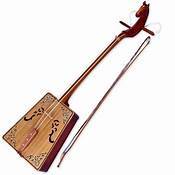
马头琴,蒙古语称莫林胡尔,是蒙古族拉弦乐器,因琴杆上端雕有马头而得名,相传公元十二世纪已在蒙古族中流传。
音箱为松木制成,呈梯形,两面蒙以马皮或羊皮,琴杆细长,用榆木或紫檀木制。两根弦,用马尾制成,弓毛也是马尾制造,演奏时弓子不夹在弦中。马头琴发音低沉,音量较小,定弦与一般拉弦乐器相反,外弦音低,内弦音高,多为四度定弦。
马头琴除了作为独奏乐器外,也是民歌、说唱音乐的伴奏乐器,也可与四胡等合奏。
演奏方法常用以下两种:一种是用左手指的二、三关节处按弦;一种是用指甲从弦下向上顶弦。后一种指法所发音量较前一种大而清亮,声音结实有力。因琴弓和琴身分开,所以可奏出双音,增加了色彩和表现力。马头琴善于演奏柔和细腻的抒情乐曲,特别适合于演奏悠长辽阔的旋律,在伴奏民歌时,多用三度、四度的颤音来模仿演唱者的一些特点。
新中国成立后,对马头琴进行了改革,扩大了音箱,改用蟒皮蒙面;弓子改为富于弹性的弓子,用尼龙丝弦代替马尾弦,使音量增大。将定弦提高了四度,既保持了马头琴原有的柔和、深厚的音色,又增加了清晰、明亮、有力的特点。
Matouqin is a Mongolian folk string instrument with a long history since 12th century. It has a horse head carved in the upper part of the stem, so it is called matouqin ( horse-head qin). The instrument is made of wood about a meter in length. The sound box is in the shape of a trapezoid covered with horse or sheep skin. The string is made from the hair of horse tail. When a bow is drawn between the two strings, the mellow sound is thus erected. It is the most commonly used musical instrument in Mongolian minorities, often used in solo, in accompaniment and in ensemble. There are two special fingering skills for matouqin performance. One is that using the second or third joint of the left hand finger to press the string. Another one is using the nail to push up the string. The sound is louder and clearer in using the latter fingering than the former one. In new China, matouqin has been reformed by using nylon strings instead of horse tail. The volume is increased, the sound quality is more clear, bright and strong.

